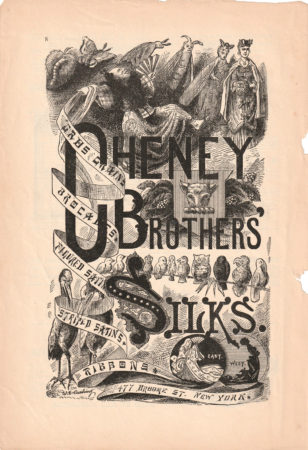The story begins with the white mulberry tree, the only food of the silkworm caterpillar. Silk culture began in the American colonies around 1613 when silkworm eggs and mulberry seeds were imported to Virginia and then to other colonies. Mulberry trees were valuable but a testy and demanding crop. Recurrent blights wreaked havoc on farms across the northeast and following the Panic of 1837, investors stopped giving money to the silk “experiment”. Mulberry farms disappeared, and by 1840 the silk speculation bubble had entirely burst.

The Cheneys, however, acted before the silk crash took effect. They had the foresight to determine that the future of the American silk market lay not in the production of the raw material but in its processing. Ward, Frank and Rush Cheney partnered with brother Ralph and colleague Edwin Arnold in 1838 to open Mt. Nebo Silk Mills in Manchester, in a plant adjacent to the Hop Brook River. Older brothers Seth and John, successful engravers, made periodic loans to their entrepreneurial brothers’ fledging enterprise. The story of the family is intertwined with their business.
Beginning in 1838, Cheney Brothers built the silk mills that made Manchester famous and drew workers from throughout the United States and Europe. During the second Industrial Revolution (1860-1890), the Cheney business prospered, and eventually became the largest silk manufacturer in the country, and the only one to manage all phases of silk production except raising silkworms. Attempts to grow mulberry trees to nurture silkworms had failed, and the Cheneys imported silk cocoons from the Orient.

By the early 1920s, the mills employed 4,700 workers, which was 25 percent of the town’s population. The Cheney family constructed the mill buildings between 1872 and 1917. The Cheneys also built firehouses, electric and gas companies, schools, reservoirs, and hundreds of worker houses. Cheneys supported the construction of churches and other public buildings. They provided their employees with insurance, medical care, and retirement benefits. The Cheneys were entrepreneurs, business executives, inventors, abolitionists, artists, architects, authors, philanthropists, and influential citizens of the town and state.
After the peak year of 1923, the silk industry began to decline. Cheney Brothers fell on hard times during the 1930s, due in part to the Great Depression, the elimination of protective import tariffs, new fashion trends, and the arrival of synthetics. Textile production from all over New England moved to the southern states and to the Orient, where labor was cheaper. After reorganizing in 1935, Cheney Brothers rebounded somewhat during World War II with the development and production of nylon parachutes (Pioneer Parachute). But in 1955, the family made the painful decision to sell the company to J.P. Stevens, which immediately discontinued some operations, moved and sold off others. The last surviving textile operation—the Velvet Mill—closed in 1984. In the 1980s and 1990s, many of the empty mills were renovated and adapted for use as apartments.
paragraphs 3-5 by Susan Barlow, Manchester Historical Society
See a photo gallery of Cheney Silks ads
